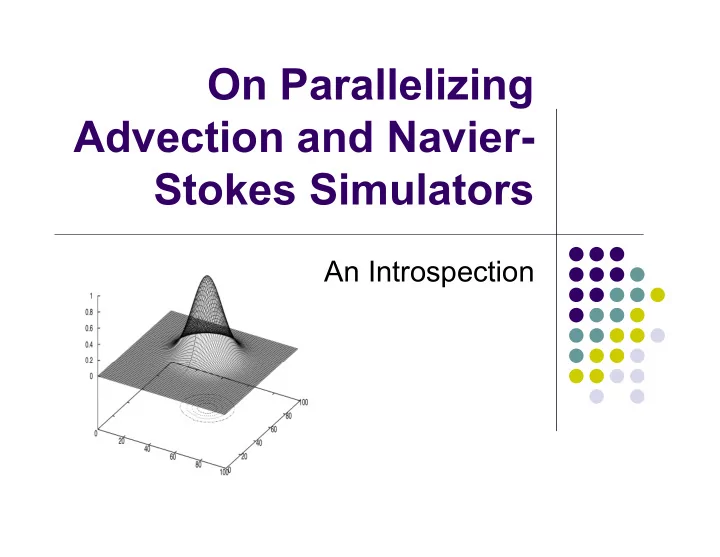

On Parallelizing Advection and Navier- Stokes Simulators An Introspection
Project Goals To parallelize An advection simulator that creates a matrix stored to disk A Navier-Stokes simulator that has the ability to store output to disk
Advection Challenges Initialization for(i=1;i<nx-1;i++) for(j=1;j<ny-1;j++){ x = (i-1)*dx; y = (j-1)*dy; gmesh[i][j] = amp*exp(-50*( (x-x0)*(x-x0) + (y-y0)*(y-y0))); } How to assign values when data is expected to be distributed continuously across the grid?
Advection Challenges I/O - the program needs to output all the data to a file so that it can be plotted… Three mildly unsuccessful attempts: Send all data to one node, then output 1. Let each node write to the file is exact place 2. Doesn’t work, instead do this sequentially Use MPI_File routines 3. Bad idea. Lessons learned: mmap
Advection - Results
Advection - Results - No I/O
Navier-Stokes Challenges Size of program A generous helping of code duplication 20 separate sections that modified data Non-standard indexing and matrices Velocity matrices Performing different work for top, middle, bottom Exchanging ghost corners
Navier-Stokes Challenges Ghost corners
Navier Stokes I/O Used “dd” to create files of appropriate size quickly. Used mmap to memory map files, which allowed each CPU to write data at the same time
Navier-Stokes Results
Navier-Stokes Results ? Can we take a closer look?
Navier-Stokes Results What happened? There’s one stage in the program that uses a Poisson solver. The solver is not parallelized (it’s in Fortran) and all data had to be collected on one node
Navier-Stokes Results How much time is spent in the Poisson solver? A test run was done with code profiling Running time: 43.86s Time spent with Poisson solver including gathering and scatter: 42.048s (95.8%) Time spent in Poisson solver only: 40.72s (92.8%)
Conclusion Use mmap Initialize on separate processors Avoid excessive communication Avoid parallelizing other people’s code =)
Recommend
More recommend